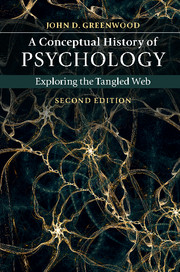Book contents
- Frontmatter
- Contents
- Preface
- 1 History, science, and psychology
- 2 Ancient Greek science and psychology
- 3 Rome and the medieval period
- 4 The scientific revolution
- 5 The Newtonian psychologists
- 6 Physiology and psychology
- 7 Theories of evolution
- 8 Psychology in Germany
- 9 Psychology in America: the early years
- 10 Functionalism, behaviorism, and mental testing
- 11 Neobehaviorism, radical behaviorism, and problems of behaviorism
- 12 The cognitive revolution
- 13 Abnormal and clinical psychology
- Epilogue: the past and future of scientific psychology
- Index
- References
10 - Functionalism, behaviorism, and mental testing
Published online by Cambridge University Press: 05 September 2015
- Frontmatter
- Contents
- Preface
- 1 History, science, and psychology
- 2 Ancient Greek science and psychology
- 3 Rome and the medieval period
- 4 The scientific revolution
- 5 The Newtonian psychologists
- 6 Physiology and psychology
- 7 Theories of evolution
- 8 Psychology in Germany
- 9 Psychology in America: the early years
- 10 Functionalism, behaviorism, and mental testing
- 11 Neobehaviorism, radical behaviorism, and problems of behaviorism
- 12 The cognitive revolution
- 13 Abnormal and clinical psychology
- Epilogue: the past and future of scientific psychology
- Index
- References
Summary
In the early decades of the twentieth century, Wundt's students and the indigenous pioneers of American psychology continued to promote and develop their varied conceptions of scientific psychology. Cattell claimed in his 1895 presidential address to the APA that the “wide range of individual interests” of American psychologists demonstrated their “adjustment in a complex environment” (1896, p. 134). Yet these different interests also proved to be forces of division in the following decades, sometimes characterized as the period of the competing “schools” of psychology (Murchison, 1930; Woodworth, 1931).
Titchener's form of structural psychology remained an intellectual force in the first two decades of the twentieth century, but became increasingly isolated at Cornell and was eventually displaced by functionalist and behaviorist psychology. As the twentieth century progressed, psychology in America distanced itself from its philosophical roots, including the notion that scientific psychology should be grounded in the introspective analysis of consciousness. Many psychologists had abandoned introspective methods by the time John B. Watson issued his behaviorist “manifesto” in 1913 (Watson, 1913a). This was partly because of the “imageless thought” debate, but also because they had little use for introspection in their applied educational, industrial, and clinical work. In addition, psychology in America distanced itself from its roots in German physiological psychology. Although courses and demonstration practicals in laboratory methods continued to be employed in the PhD certification of American psychologists as bona fide practitioners of scientific psychology, the “brass instruments” of the new psychology were increasingly appropriated and adapted by educational, industrial, and clinical psychologists as part of their battery of mental and physical aptitude tests.
Many psychologists who came to embrace Watson's (1913a) call for a behavioral science of prediction and control did so because it suited their already well developed applied interests, not because they were convinced by Watson's arguments or rhetoric. These interests were frequently a product of the various institutional and social pressures and opportunities that promoted the development of applied psychology in the first two decades of the twentieth century. Indeed, Watson's own goal of developing a behaviorist psychology had as much to do with his own professional career interests and institutional realities as his avowed arguments against introspection and in favor of a positivistic science of behavior.
- Type
- Chapter
- Information
- A Conceptual History of PsychologyExploring the Tangled Web, pp. 344 - 409Publisher: Cambridge University PressPrint publication year: 2015



